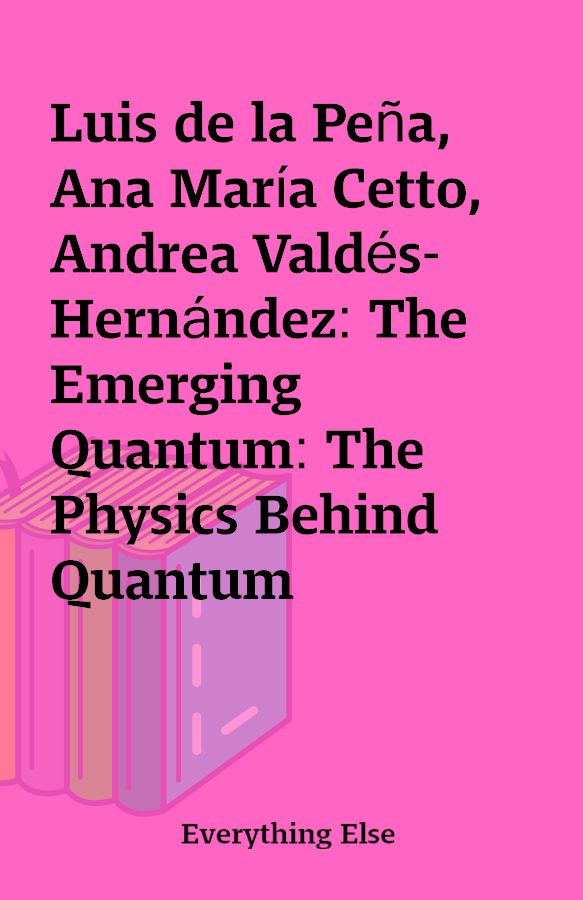Luis de la Peña, Ana María Cetto, Andrea Valdés-Hernández: The Emerging Quantum: The Physics Behind Quantum Mechanics
Luis de la Pena, Ana Maria Cetto, Andrea Valdes-Hernandez-The Emerging Quantum_ The Physics Behind Quantum Mechanics-SpringerTP
[1 ebook – PDF]
Description
The Emerging Quantum: The Physics Behind Quantum Mechanics By Luis de la Peña, Ana María Cetto, Andrea Valdés-HernándezPublished by Springer in 2014PDF, 366 pages, English (ISBN:3319078933)This monograph presents the latest findings from a long-term research project intended to identify the physics behind Quantum Mechanics. A fundamental theory for quantum mechanics is constructed from first physical principles, revealing quantization as an emergent phenomenon arising from a deeper stochastic process. As such, it offers the vibrant community working on the foundations of quantum mechanics an alternative contribution open to discussion. The book starts with a critical summary of the main conceptual problems that still beset quantum mechanics. The basic consideration is then introduced that any material system is an open system in permanent contact with the random zero-point radiation field, with which it may reach a state of equilibrium. Working from this basis, a comprehensive and self-consistent theoretical framework is then developed. The pillars of the quantum-mechanical formalism are derived, as well as the radiative corrections of nonrelativistic QED, while revealing the underlying physical mechanisms. The genesis of some of the central features of quantum theory is elucidated, such as atomic stability, the spin of the electron, quantum fluctuations, quantum nonlocality and entanglement. The theory developed here reaffirms fundamental scientific principles such as realism, causality, locality and objectivity.Table of contents :Contents1 Quantum Mechanics: Some Questions1.1 On Being Principled… At Least on Sundays1.1.1 The Sins of Quantum Mechanics1.2 The Two Basic Readings of the Quantum Formalism1.2.1 The Need for an Interpretation1.2.2 A Single System, or an Ensemble of Them?1.3 Is Realism Still Alive?1.4 What is this Book About?1.4.1 The Underlying Hypothesis1.4.2 The System Under Investigation.References2 The Phenomenological Stochastic Approach: A Short Route to Quantum Mechanics2.1 Why a Phenomenological Approach to Quantum Mechanics?2.2 The Stochastic Description of Quantum Mechanics2.3 Stochastic Quantum Mechanics2.3.1 Kinematics.2.3.2 Spatial Probability Density and Diffusive Velocity2.3.3 Dynamics2.3.4 Integrating the Equation of Motion2.3.5 Quantum and Classical Stochastic Processes2.4 On Schrödinger-Like Equations2.5 Stochastic Quantum Trajectories.2.5.1 Wavelike Patterns.2.6 Extensions of the Theory, Some Brief Comments, and Assessment2.6.1 A Summing UpReferences3 The Planck Distribution, a Necessary Consequence of the Fluctuating Zero-Point Field3.1 Thermodynamics of the Harmonic Oscillator3.1.1 Unfolding the Zero-Point Energy3.2 General Thermodynamic Equilibrium Distribution3.2.1 Thermal Fluctuations of the Energy3.2.2 Some Consequences of the Recurrence Relation.3.3 Planck’s Law from the Thermostatistics of the Harmonic Oscillator.3.3.1 General Statistical Equilibrium Distribution3.3.2 Mean Energy as Function of Temperature; Planck’s Formula3.4 Planck, Einstein and the Zero-Point Energy3.4.1 Comments on Planck’s Original Analysis3.4.2 Einstein’s Revolutionary Step3.4.3 Disclosing the Zero-Point Field3.5 Continuous Versus Discrete3.5.1 The Partition Function3.5.2 The Origin of Discreteness3.6 A Quantum Statistical Distribution3.6.1 Total Energy Fluctuations3.6.2 Quantum Fluctuations and Zero-Point Fluctuations3.6.3 Comments on the Reality of the Zero-PointFluctuationsReferences4 The Long Journey to the Schrödinger Equation4.1 Elements of the Dynamics4.1.1 The Equation of Motion4.1.2 Basic Properties of the Zero-Point Field4.2 Generalized Fokker-Planck Equation in Phase Space4.2.1 Some Important Relations for Average Values4.3 Transition to Configuration Space4.3.1 A Digression: Transition to Momentum Space4.3.2 A Hierarchy of Coupled Transfer Equations4.4 The Schrödinger Equation4.4.1 The Radiationless Approximation4.4.2 Statistical and Quantum Averages4.4.3 Stationary Schrödinger Equation.4.4.4 Detailed Energy Balance: The Entry Point for Planck’s Constant4.4.5 Schrödinger’s i4.5 Further Insights into the Quantum Description4.5.1 Fluctuations of the Momentum.4.5.2 Local Velocities: ‘Hidden’ Information Contained in Psi4.5.3 A Comment on Operator Ordering4.5.4 Trapped Motions4.5.5 ‘Schrödinger’ Equation for a Classical System?4.6 Phase-Space Distribution and the Wigner Function.4.7 What We Have Learned So Far About Quantum MechanicsReferences5 The Road to Heisenberg Quantum Mechanics5.1 The Same System: A Fresh Approach.5.1.1Description of the Mechanical Subsystem5.1.2Resonant Solutions in the Stationary Regime5.2 The Principle of Ergodicity5.2.1 The Chain Rule5.2.2 Matrix Algebra.5.3 Physical Consequences of the Ergodic Principle.5.3.1 Establishing Contact with Quantum Theory5.3.2 The Radiationless Approximation5.3.3 The Canonical Commutator [p^,x^]5.4 The Heisenberg Description5.4.1 Heisenberg Equation, Representations, and Quantum Transitions.5.4.2 The Hilbert-Space Description and State Vectors5.4.3 Transition to the Schrödinger Equation5.4.4 The Stochastic Representation5.5 Concluding RemarksReferences6 Beyond the Schrödinger Equation6.1 Radiative Corrections. Contact with QED6.1.1 Radiative Transitions6.1.2 Breakdown of Energy Balance6.1.3 Atomic Lifetimes: Einstein’s A and B Coefficients6.1.4 A More General Equation for the Balance Breakdown6.1.5 Radiative Corrections to the Energy:The Lamb Shift6.1.6 External Effects on the Radiative Corrections6.2 The Spin of the Electron6.2.1 Unravelling the Spin6.2.2 The Isotropic Harmonic Oscillator6.2.3 General Derivation of the Electron Spin6.2.4 Angular Momentum of the Zero-Point Field6.2.5 Gyromagnetic Factor for the Electron6.3 Concluding CommentsReferences7 Disentangling Quantum Entanglement.7.1 The Two-Particle System.7.1.1The Field in the Vicinity of the Particles.7.1.2Looking for Stationary Solutions7.1.3The Common Random Variable7.1.4Establishing Contact with the Tensor Product Hilbert Space7.1.5Implications of Ergodicity for the Common Random Field Variable7.2 Correlations Due to Common Resonance Modes7.2.1Spectral Decomposition.7.2.2State Expansion Versus Energy Expansion7.2.3State Vectors: Emergence of Entanglement7.2.4Entanglement as a Vestige of the ZPF7.2.5Emergence of Correlations.7.3 Systems of Identical Particles.7.3.1Natural Entanglement7.3.2The Origin of Totally (Anti)symmetric States7.3.3Comments on Particle Exchange7.4 Spin-Symmetry Relations7.4.1Two Electrons in the Singlet State7.4.2The Helium Atom7.5 Final CommentsReferences8 Causality, Nonlocality, and Entanglement in Quantum Mechanics8.1 Causality at Stake.8.1.1Von Neumann’s Theorem8.1.2Bohm’s Counterexample8.2 Essentials of the de Broglie-Bohm Theory8.2.1The Guiding Field8.2.2Quantum Trajectories8.2.3The Measurement Task in the Pilot Theory8.3The Quantum Potential8.3.1Linearity and Nonlocality8.3.2Linearity and Fluctuations8.3.3The Quantum Potential as a Kinetic Term8.4 Nonlocality in Bipartite Systems8.4.1Nonlocality and Entanglement8.4.2Momentum Correlations8.4.3The Whole and the Parts8.4.4Nonlocality and Noncommutativity8.5 Final RemarksReferences9 The Zero-Point Field Waves (and) Matter9.1 Genesis of de Broglie’s Wave9.1.1The de Broglie ‘Clock’9.1.2Energy, Frequency and Matter Waves9.1.3The de Broglie Wave9.2 An Exercise on Quantization à la de Broglie9.3 Undulatory Properties of Matter9.4 Cosmological Origin of Planck’s Constant.References10 Quantum Mechanics: Some Answers.10.1 The Genetic Gist of the Zero-Point Field.10.1.1 Origin of Quantization10.1.2 Recovering Realistic Images10.2 Some Answers10.3 The Photon10.4 Limitations and Extensions of the TheoryReferencesSuggested LiteratureIndex
You must be logged in to post a review.






Reviews
There are no reviews yet.